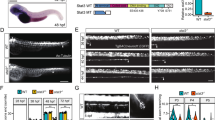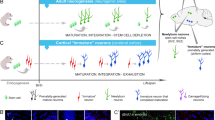Summary
1. To investigate the role of the Jun transcription factors in neuronal differentiation, programmed neuronal cell death, and neuronal plasticity, we used phosphorothioate oligodeoxynucleotides (S-ODN) to inhibit selectively the expression of c-Jun, JunB, and JunD.
2. We have shown previously that in contrast to c-Jun, the JunB and JunD transcription factors are negative regulators of cell growth in various cell lines. Here we confirm this finding in primary human fibroblasts.
3. c-Jun and JunB are counterplayers not only with respect to proliferation, but also in cell differentiation. Since JunB expression is essential for neuronal differentiation, we analyzed possible posttranslational modifications of JunB after induction of PC-12 cell differentiation by nerve growth factor (NGF).
4. JunB was strongly phosphorylated after induction of PC-12 cell differentiation with NGF but not after stimulation of cell proliferation with serum. Thus, while cell proliferation is associated with c-Jun phosphorylation, cell differentiation is correlated with JunB phosphorylation. This supports the finding that c-Jun and JunB play antagonistic roles in both proliferation and differentiation.
5. The JunB transcription factor together with the c-Fos transcription factor is also inducedin vivo in the suprachiasmatic nucleus (SCN) of rat brain after a light stimulus that induces resetting of the circadian clock.
6. Using antisense oligonucleotides injected into the third ventricle, we selectively cosuppressed the two transcription factorsin vivo as shown by immunohistochemistry. Expression of c-Jun, JunD, and FosB was not affected. Inhibition of JunB and c-Fos expression prevented the light-induced phase shift of the circadian rhythm. In contrast, rats injected with a randomized control oligonucleotide showed the same phase shift as untreated animals.
7. In primary rat hippocampal cultures, anti-c-jun S-ODN selectively inhibited neuronal cell death and promoted neuronal survival. This indicates a causal role of c-Jun in programmed neuronal cell death.
8. These findings demonstrate the essential role of inducible transcription factors in the reprogramming of cells to a different functional state. Jun transcription factors play an essential role not only in fundamental processes such as cell proliferation, differentiation, and programmed neuronal cell death, but also in such complex processes as plastic adaptations in the mature brain. The inhibition of neuronal cell death by anti-c-jun S-ODN shows the great therapeutic potential of selective antisense oligonucleotides.
Similar content being viewed by others
References
Behl, C., Winkler, J., Bogdahn, U., Meixensberger, J., Schlingensiepen, K.-H., and Brysch, W. (1993). Autocrine growth regulation in neuroectodermal tumors as detected with oligodeoxynucleotide antisense molecules.Neurosurgery 33679–684.
Binetruy, B., Smeal, T., and Karin, M. (1991). Ha-ras augments c-Jun activity and stimulates phosphorylation of its activation domain.Nature 351122–127.
Brysch, W., Rifai, A., Tischmeyer, W., and Schlingensiepen, K.-H. (1994). Rational drug design, pharmacokinetics, intracerebral application and organ uptake of antisense phosphorothioate oligodeoxynucleotides. In (S. Agrawal, Ed.),Antisense Oligonucleotide Therapy: Current Status, Humana Press, Clifton, NJ (in press).
Chiu, R., Angel, P., and Karin, M. (1989). Jun-B differs in its biological properties from and is a negative regulator of c-Jun.Cell 59979–986.
Daan, S., and Pittendrigh, C. S. (1976). A functional analysis of circadian pacemakers in nocturnal rodents. II. The variability of phase response curves.J. Comp. Physiol. A 106253–266.
Dungy, L. J., Siddiqi, T. A., and Khan, S. (1991). c-jun and jun-B oncogene expression during placental development.Am. J. Obstet. Gynecol. 1651853–1856.
Gass, P., Herdegen, T., Bravo, R., and Kiesling, M. (1993). Induction of six immediate-early gene encoded proteins in the rat brain after kainic acid induced limbic seizures: effects of NMDA receptor antagonist MK-801.Eur. J. Neurosci. 5933–943.
Gillardon, F., Beck, H., Herdegen, T., Sandkühler, J., and Zimmermann, M. (1994). Inhibition of c-Fos protein expression in rat spinal cord by antisense oligodeoxynucleotide superfusion.Eur. J. Neuroscience (in press).
Herdegen, T., Tölle, T., Bravo, R., Zieglgänsberger, W., and Zimmermann, M. (1991). Sequential expression of JUN B, JUN D and FOS B proteins in rat spinal neurons: Cascade of transcriptional operations during nociception.Neurosci. Lett. 129221–224.
Herdegen, T., Brecht, S., Mayer, B., Leah, J., Kummer, W., Bravo, R., and Zimmermann, M. (1993). Long-lasting expression of Jun and Krox transcription factors and nitric oxide synthase in intrinsic neurons of the rat brain following axotomy.J. Neurosci. 134130–4145.
Jachimczak, P., Bogdahn, U., Schneider, J., Behl, C., Meixensberger, J., Apfel, R., Dörries, R., Schlingensiepen, K.-H., and Brysch, W. (1993). TGF-beta2-specific phosphorothioate-antisense oligodeoxynucleotides may reverse cellular immunosuppression in malignant glioma.J. Neurosurg. 78944–951.
Kornhauser, J. M., Nelson, D. E., Mayo, K. E., and Takahashi, J. S. (1992). Regulation ofjun-B messenger RNA and AP-1 activity by light and a circadian clock.Science 2551581–1584.
Kovary, K., and Bravo, R. (1991). Expression of different JUN and FOS proteins during the G0 to G1 transition in mouse fibroblasts:In-vitro andin-vivo associations.Mol. Cell. Biol. 112451–2459.
Lev-Lehmann, E., Hornreich, G., Ginzberg, D., Gnatt, A., Meshorer, A., Eckstein, F., Soreq, H., and Zakut, H. (1994). Antisense inhibition of acetylcholinesterase gene expression causes transient hematopoietic alterationsin-vivo Gene Ther.2127–135.
Morgan, J. I., and Curran, T. (1991). Human proto-oncogene c-jun encodes a DNA binding protein with structural and functional properties of transcription factor AP-1Annu. Rev. Neurosci. 14421–451.
Patinkin, D., Seidman, S., Eckstein, F., Benseler, F., Zakut, H., and Soreq, H. (1990). Manipulations of cholinesterase gene expression modulate Murine megakaryocytopoiesisin vitro.Mol. Cell. Biol. 106046–6050.
Pfarr, C. M., Mechta, M., Spyrou, G., Lallemand, D., Carillo, S., and Yaniv, M. (1994). Mouse JunD negatively regulates fibroblast growth and antagonizes transformation byras.Cell 76747–760.
Ryseck, R.-P., and Bravo, R. (1991). c-JUN, JUN B and JUN D differ in their binding affinities to AP-1 and CRE consensus sequences: Effect of FOS proteins.Oncogene 6533–542.
Sauer, f., and Jäckle, H. (1993). Dimerization and the control of transcription by Krüppel.Nature 364454–457.
Schlingensiepen, K.-H., and Brysch, W. (1992). Phosphorothioate oligomers: Inhibitors of oncogene expression in tumor cells and tools for gene function analysis. InGene Regulation: Biology of Antisense RNA and DNA (R. Erickson and J. Izant, Eds.), Raven Press, New York, pp. 317–328.
Schlingensiepen, K.-H., Schlingensiepen, R., Kunst, M., Klinger, I., Gerdes, W., Seifert, W., and Brysch W. (1993). Opposite functions ofjun-B and c-jun in growth regulation and neuronal differantiation.Dev. Genet. 14305–312.
Schlingensiepen, K.-H., Kunst, M., Gerdes, W., and Brysch, W. (1994). Complementary expression patterns of c-jun andjunB in rat brain and analysis of their function with antisense oligonucleotides. InImmediate Early Genes: More than Activity Markers (T. Tölle and W. Zieglgänsberger, Eds.), Springer, Berlin, Heidelberg (in press).
Schütte, J., Viallet, J., Nau, M., Segal, S., Fedorko, J., and Minna, J. (1989). Jun-B inhibits and c-fos stimulates the transforming and transactivating activities of c-jun.Cell 59987–997.
Seifert, W., Rantscht, B., Fink, H. J., Förster, F., Beckh, S., and Müller, H. W. (1983). Development of hippocampal neurons in cell culture: A molecular approach. InNeurobiology of the Hippocampus (W. Seifert, Ed.), Academic Press, London, pp. 109–135.
Sheng, M., and Greenberg, M. E. (1990). The regulation and function of c-fos and other immediate early genes in the nervous system.Neuron 4477–485.
Smeal, T., Binetruy, B., Nercola, D., Birrer, M., and Karin, M. (1991). Oncogenic and transcriptional cooperation with Ha-Ras requires phosphorylation of c-Jun on serines 63 and 73.Nature 354494–496.
Stein, C. A., and Cheng, Y.-C. (1993). Antisense oligonucleotides as therapeutic agents—Is the bullet really magical?Science 2611004–1012.
Takahashi, J. S. (1993). Circadian-clock regulation of gene expression.Curr. Opin. Genet. Dev. 3301–309.
Tischmeyer, W., Grimm, R., Schicknick, H., Brysch W., and Schlingensiepen K.-H. (1994). Sequence-specific impairment of learning by c-jun antisense oligonucleotides.Neuroreport 51501–1504.
Vogt, P. K., and Bos, T. J. (1990).jun: Oncogene and transcription factor.Adv. Cancer Res. 551–35.
Wilkinson, D. G., Bhatt, S., Ryseck, R. P., and Bravo, R. (1989). Tissue-specific expression of c-jun and jun-B during organogenesis in the mouse.Development 106465–471.
Wollnik, F. (1991). Strain differences in the pattern and intensity of wheel running activity in laboratory rats.Experientia 47 593–598.
Wollnik, F. (1992). Neural control of circadian rhythm in mammals.Verh. Dtsch. Zool. Ges. 85231–246.
Wyllie, A. H. (1993). Apoptosis.Br. J. Cancer 67205–208.
Author information
Authors and Affiliations
Rights and permissions
About this article
Cite this article
Schlingensiepen, KH., Wollnik, F., Kunst, M. et al. The role of Jun transcription factor expression and phosphorylation in neuronal differentiation, neuronal cell death, and plastic adaptationsin vivo . Cell Mol Neurobiol 14, 487–505 (1994). https://doi.org/10.1007/BF02088833
Received:
Issue Date:
DOI: https://doi.org/10.1007/BF02088833




